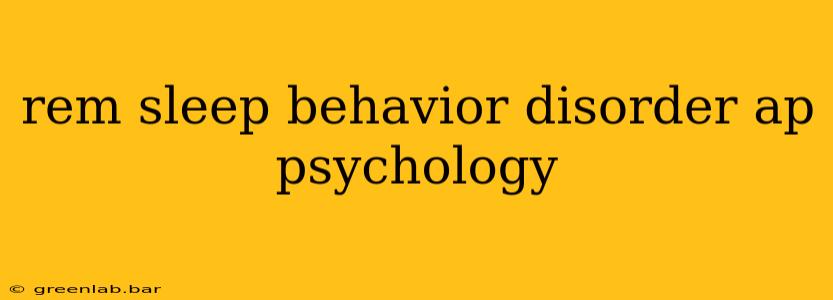REM sleep behavior disorder (RBD) is a neurological disorder characterized by the loss of normal muscle atonia during rapid eye movement (REM) sleep. This results in individuals acting out their dreams, often violently or aggressively. While seemingly a niche topic, understanding RBD holds significant implications for sleep medicine, neurology, and even psychology, particularly within the context of Ap Psychology curricula. This in-depth exploration will delve into the symptoms, causes, diagnosis, and treatment of RBD, highlighting its relevance to the broader understanding of sleep and neurological function.
Understanding REM Sleep and Muscle Atonia
Before diving into RBD, let's establish a foundational understanding of REM sleep. REM, or rapid eye movement, sleep is a distinct stage of the sleep cycle characterized by rapid eye movements, vivid dreams, and a near-paralyzed state. This paralysis, known as muscle atonia, prevents us from physically acting out our dreams, ensuring our safety. The paradoxical nature of REM sleep lies in the brain being highly active while the body remains essentially immobile. RBD disrupts this crucial mechanism.
Symptoms of REM Sleep Behavior Disorder
The hallmark symptom of RBD is the acting out of dreams. This can manifest in a variety of ways, ranging from subtle movements to violent behaviors including:
- Kicking, punching, and flailing: These actions often correspond to the dream's content, though the individual is usually unaware of their actions upon waking.
- Talking, shouting, or laughing: Vocalizations during sleep can be a significant symptom, often disturbing sleep partners.
- Getting out of bed and engaging in complex behaviors: This can pose serious safety risks, particularly if the individual is unaware of their surroundings.
- Injuries to self or sleep partner: The physical nature of dream enactment can lead to injuries, both for the individual with RBD and those sharing their bed.
The severity of symptoms can vary greatly, and early symptoms might be subtle, easily overlooked, or attributed to other causes. It's important to note that simple restlessness during sleep is not RBD. The key distinguishing factor is the direct connection between the sleep behavior and dream content.
Recognizing the Signs: A Crucial First Step
Early detection of RBD is critical for both safety and effective management. If you or a loved one experiences any of the aforementioned symptoms, seeking professional medical advice is paramount. A thorough sleep evaluation can help distinguish RBD from other sleep disorders.
Causes and Risk Factors of RBD
The exact cause of RBD remains an area of ongoing research. However, several factors are strongly implicated:
- Neurological degeneration: RBD is frequently associated with neurodegenerative disorders, most notably Parkinson's disease, multiple system atrophy (MSA), and dementia with Lewy bodies. It is often considered a prodromal marker, meaning it can precede the onset of these more severe conditions by years, sometimes even a decade or more.
- Genetic predisposition: While not fully understood, genetic factors likely play a role in the susceptibility to developing RBD. Family history of neurological disorders increases the risk.
- Medications and substances: Certain medications and substances, including alcohol and some antidepressants, can disrupt sleep architecture and potentially contribute to or worsen RBD symptoms.
Diagnosis of REM Sleep Behavior Disorder
Diagnosis involves a combination of:
- Detailed sleep history and physical examination: A thorough evaluation of sleep behaviors and medical history is essential.
- Polysomnography (PSG): This sleep study measures various physiological parameters during sleep, including brain waves, eye movements, muscle activity, and heart rate. PSG definitively confirms the loss of muscle atonia during REM sleep.
- Neurological examination: This helps rule out other neurological conditions that might mimic RBD symptoms.
Treatment Options for REM Sleep Behavior Disorder
Treatment aims to improve safety and reduce the severity of symptoms. Common approaches include:
- Clonazepam: This medication is often prescribed to reduce muscle activity during sleep and prevent dream enactment.
- Other medications: In some cases, other medications might be considered, depending on the individual's overall health and specific symptoms.
- Safety measures: These are crucial, particularly for individuals with severe symptoms. This includes removing potential hazards from the sleeping environment and sleeping alone or with a sleep partner who can monitor the individual.
RBD and its Implications for Ap Psychology
The study of RBD offers valuable insights into several key concepts within Ap Psychology:
- Sleep cycles and stages: Understanding the complexities of REM sleep and its role in dreaming is fundamental.
- Neurological processes: RBD highlights the intricate interplay between the brain and the body during sleep.
- Abnormal behavior and neurological disorders: It showcases how disruptions in neurological function can lead to significant behavioral changes.
- Diagnosing and treating sleep disorders: The process of diagnosing and managing RBD provides a case study in clinical psychology and neurology.
Understanding REM sleep behavior disorder offers a captivating and informative lens through which to explore the fascinating and complex relationship between the mind, the body, and sleep. Its inclusion within Ap Psychology curricula emphasizes the importance of holistic approaches to understanding behavior and the significance of neurological factors in shaping human experience.

